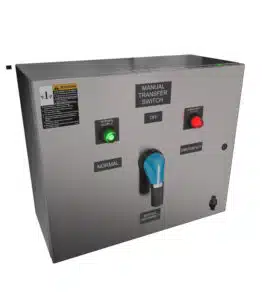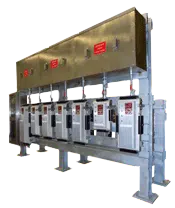Usually, during a power cut, you have to take the extension cords from your electrical appliances and connect them to the generator. You may have to keep the doors and windows open to run the extension cords.
But if you have a manual transfer switch, you can save yourself from such tough jobs if there is a power outage. A manual transfer switch connects the generator directly to the circuits.
You do not need to run any cord through the house to reach the generator. Let us delve further into the mechanism of a manual transfer switch.
What is a transfer switch?
A transfer switch shifts the electrical load between two sources, and it can either be a manual one or an automatic one.
- Manual transfer switch
- In case of a manual transfer switch, the operator needs to manually transfer the electrical load to the generator by using the switch.
- Automatic transfer switch
- In this case, the operator does not need to do anything. The switch automatically shifts the power from one source to another whenever it senses that one source has lost power. It is installed near the backup power generator and switches on automatically in case of a power cut. It provides temporary electrical power till the electricity is restored.
An automatic transfer switch is better for large properties in blackout prone areas and requires extra investment to install and maintain. They are good for commercial spaces like shopping malls or public places like hospitals where there shouldn’t be any interruption in the power supply. However, it is easier for small homes to use a low-cost manual transfer switch and maintain it without much expense.
How does a manual transfer switch work?
A manual transfer switch connects the house’s electrical circuits to the generator. During a power outage, you can use it to switch on the backup power. Any appliance connected to the circuit will run on backup power till electricity is restored. The manual transfer switch can be installed both indoors and outdoors.
The number of circuits you can connect through the manual transfer depends on the generator’s power output. The manual transfer switch is connected to the main electrical circuit panels. It is then wired and fixed to a power inlet box. The generator connects to the power inlet box in case of a power cut. A professional electrician will complete the wiring and create the power transfer system, connecting the generator with the electrical panel, the cords, and the power inlet box through the transfer switch.
- It is much safer than extending power cords from the home to the generator located somewhere near the garage.
- It is easy to shift the load to the generator with just a switch when there is a need.
- It connects to the whole service panel.
- It gives you the full control to decide if you want to turn on the generator for a temporary power supply at the present moment.
- It is less expensive to install and maintain that an automatic transfer switch.
How do you operate a manual transfer switch?
During a blackout, here are the steps to follow if you have installed a manual transfer switch.
- Read and follow the safety manuals beforehand so that you are not completely a novice during the blackout.
- Firstly, turn off the circuits in the transfer switch.
- Use a gen cord to connect your manual transfer switch with the generator.
- Start the generator and let it function for some time to warm it up.
- Change the transfer switch from ‘Line’ to ‘Generator’ to shift the power load.
- Now, turn on the circuits that you wish to power through the generator backup. Try not to overload the generator.
- When the electricity is restored, change the manual transfer switch from ‘generator’ to ‘line’ to shift the power supply.
- Switch off the generator and disconnect any cord that connects the switch and the generator.
How to understand the correct size of a manual transfer switch and avoid overloading the generator?
The size of the manual transfer switch must match the largest outlet on the generator. If the largest outlet measures 30amps or more, the manual transfer switch must be of the same ampere to function properly and take the entire load.
A manual transfer switch must also have a wattage meter to measure the power and avoid overloading the generator. This can damage both the generator and your appliances. You can keep a check on the power through the wattage meters and turn on or off the circuits accordingly.
Final Words
If you wish to be safe during a blackout, having a manual transfer switch installed at home is the safest possible method. You can also go for an automatic transfer switch if you feel that’s better for you. However, let the experts and professionals take the call regarding which kind
of transfer switch would be best for your home. Call the experts when you get a generator to decide which manual transfer switch can make things easy for your home and have them installed safely.



